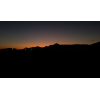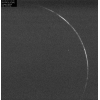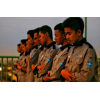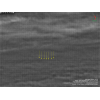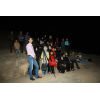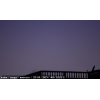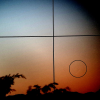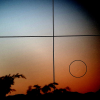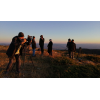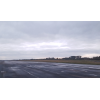Visibility of Safar Crescent 1441 AH
- When to Observe Safar Waxing (NEW) Crescent ?
- Safar Waxing (NEW) Crescent Observation Results
- The OFFICIAL First Day in Different Countries
- When to Observe Muharram Waning (OLD) Crescent ?
- Muharram Waning (OLD) Crescent Observation Results
When to Observe Safar Waxing (NEW) Crescent ?
The geocentric conjunction (Geocentric New Moon) will occur Inshalla on (Saturday 28 September 2019) at 18:26 UT.
Sighting the new crescent on (Saturday 28 September 2019) and (Sunday 29 September 2019) is shown in the below graphs using the program Accurate Times by Mohammad Odeh according to Odeh criterion. Where:-
- It is impossible to see the crescent from the areas located under the red color. Because either the Moon on this day sets before the Sunset and/or the topocentric conjunction occurs after the Sunset.
- The crescent is expected to be seen by optical aid only from the areas located under the blue color.
- The crescent is expected to be seen by optical aid from the areas located under the magenta color. In these areas the crescent could be seen by naked eye if the atmospheric conditions are superb and the observer is experienced.
- The crescent is expected to be easily visible by naked eye from the areas located under the green color.
- The crescent cannot be seen from uncolored areas, even though the Moon sets in these locations after the Sunset and the topocentric conjunction occurs before the Sunset, but the Moon is not sufficiently illuminated in order to be seen as crescent even by optical aid.
- Kindly notice that the below graph shows the possibility of seeing the crescent from areas between 60 degrees north of Equator down to 60 degrees south of Equator.


According to the Universal Hejric Calendar (UHC), which is based on the calculated crescent visibility, the start of this month in the Eastern Region will be on Monday 30 September 2019 and in the Western Region will be on Monday 30 September 2019. Kindly notice that the UHC is a pre-calculated calendar, which adopts a certain criterion to start the new Hejric month. Your country/organization might adopt different criterion to start the new Hejric month. So it is highly advised to read the UHC website before giving any judgment.
- Results of seeing the crescent, and the first day of the month in different countries will be added here Inshalla as we receive the reports from ICOP's members. If you wish to be a member in ICOP, or to know more about it, kindly click here.
Safar Waxing (NEW) Crescent Observation Results
Sun 29 September 2019
Algeria
Mr. Abdellatif Fareh said: "رغم الغبار الذي كان محملا في الجهة الغربية و بعض السحب على الأفق كما يظهر في الصورة المرافقة، إلا أنه تمت رؤية الهلال بالعين المجردة و لله الحمد"
Australia
Bahrain
Bosnia and Herzegovina
Germany
Eng. Martin Elsaesser said: "I first observed the crescent in daytime before noon with the imaging system under very good conditions, which was easy. In the afternoon clouds approached from the west. I could see the crescent visually as a faint short arc some minutes before sunset with a telescope and follow it for a few minutes after sunset, until the clouds covered it for good. I had no time to image it during these few short minutes around sunset."
Hungary
Indonesia
Mr. AR Sugeng Riyadi said: "The new crescent of Shafar 1441 AH was not sighted on Sunday, Sept 29, 2019 from Assalaam Observatory at PPMI Assalaam, Pabelan Kartasura Sukoharjo Central Java Indonesia, the sky was hazy and partly cloudy. The sun was covered by clouds 20 minutes before setting. This evwnt was attended by members of CASA, male and female students. The new crescent was seen from Ponorogo by ust. Ahmad Junaedy and his son, Lamongan, Kudus and Jepara. The moon also captured from Palu by BMKG team."
Mr. Ahmad Junaidi said: "تمت بحمد الله رؤية الهلال لأول شهر صفر 1441 من "ابن الشاطر" للمرصد بمعهد التربية الإسلامية "الإسلام" جورسان، فونوروغو، اندونيسيا"
Iran
Mr. Hossein Janghorbani said: "In the name of God Safar Crescent Observation Report The Astronomy and Geophysics Center of Shahreza – The Crescent Association of Shahreza Report by: Hossein Janghorbani (NajmoSepehr-Sadrolmonajjemin) – Manager of Shahreza Crescent Association and Red Crescent’s Astronomy and Geophysics Center Date: Sunday, 09/29/2019 Location: Damzad foothills in the East of Shahreza (latitude: 32 00 N, longitude: 51 52 E, elevation: 1825m from sea level, time zone: +3.5 GMT) Equipments: Three set of 15*70 binoculars, One set of 20*90 binoculars, One compass. Atmospheric condition: Hazy Horizon obstacles: about 2.5° Apparent Sunset: 17:42 Results: Moon crescent was seen by 15*70 binoculars by Hossein Janghorbani at 18:00, for the first time. Other group members observed crescent by binoculars subsequently. Moon crescent was seen by naked eye by Hossein Janghorbani and Reza Janghorbani and Roya Ghermezi at 18:17, for the first time. At the end of this program ,Mr Hossien Janghorbani ,manager of Astronomy and Jeo physics House of Shahreza with 24 years back ground in astronomy science and jeo physics and Natural Geography and Meteorology and Islamic Astronomy announced about climatic condition and meteorology topic during 9 months we will have variable fall and winter. Some times e may have prolonged drought and eventually we may have waterlogged in the height of frustration . As the distance between rainfall disaster to next rainfall is very long which are sings of drought .But at the end ,we will have sudden atmosphere change from February , March, April, May and June in 2020.It will happen heavy rain whit a heavy snow , hail and storm in some part of north hemisphere I the earth. It will happen a huge floods , extreme cold , snow and blizzard .The weather changes in during 9 month . But in most of the days and times forecasting the extreme cold and icy in winter and spring .In way that there is icy in some river and spring and even in some part of sea .And the people will be surprised. Although this subjects are estimated and it may have a little error and just God know that this forecasting are true or not and a God awarded of the secrets of the secrets of the world. Observers: 1.EhsanAli Alinezhad 2.MohammadReza Hadad 3.Radman Mirtavoosi 4.MohammadJavad Nikeghbal 5.MohammadSadra Nikeghbal 6.Saer AliAbedi 7.Farhad Mirzaee 8.Milad Eslami 9.Reza Janghorbani 10.Ali Janghorbani 11.Hossein Janghorbani 12.Talaat Taheri 13.Tayebeh Shafiee 14.NazaninRoghayeh Torabi 15.Zeynab Abazari 16.Toktam AliAbedi 17.Hananeh Torabi 18.Shahideh Torabi 19.Zinat Ghermezi 20.Roya Ghermezi 21.Misagh Alinezhad 22.Mohadeseh Alinezhad 23.Marzieh Mardani 24.Zohreh Karimpoor 25.Shahnaz Same 26.Soheyla Eslami 27.Shahnaz Soroori 28.Ziba Hafar 29.Masoomeh Hafar 30.Zahra Fallahi "
Iraq
Mr. Hashim Almoosawi said: "بسمه تعالى رصد هلال ذي القعدة سنة 1441 بواسطة مرصد البصرة الفلكي https://www.facebook.com/BasraAstronomicalObservatory #Basra_Astronomical_Observatory تمكن المرصد من التقاط اول الصور في الساعة 8:27 صباحا و استمر الرصد قرب مغيب الهلال. هذا و تمت رؤية الهلال بالعين المجردة بسهولة من قبل الكثير من المتمرسين في محافظات البصرة و كربلاء و النجف تلسكوب نوع: ED127 كامرا: Lumenera LT365R فلتر: 802" "
Malaysia
Morocco
Mr. Abdessamad Doukkane said: "توصلت الجمعية بصور للهلال في عدة مدن مغربية هذه احدى الصور من مدينة طنجة."
Mr. Hatim El Harrak said: "تم ولله الحمد رؤية هلال شهر صفر الخير من مدينة طنجة بالمملكة المغربية بعد مغرب شمس يوم 29 شتنبر 2019 غربت الشمس على الساعة 19:10 دقيقة بالتوقيت المحلي 18:10 بتوقيت غرينيتش وتم رؤية الهلال بعد غروب الشمس بـ 10 دقائق وتم في أول الأمر رؤية الهلال بكاميرا كانون 500d بعدسة 300-70 mm وبعد دقيقتين تم رؤيته بالعين المجردة . حيث كانت السماء صافية وظهر الهلال رقيقا جدا بالكاد يرى "
Nepal
Mr. Mohammad Aamir said: "Crescent was not sighted anywhere in Nepal and neighboring countries like India, Pakistan and Bangladesh."
Oman
Prof. Mohammed Al-Bussaidi said: "The weather was slightly cloudy especially towards the west. However, we were able to see the crescent moon by the telescope + eyepiece."
Pakistan
Mr. Ghulam Mustafa said: "The Crescent was observed with 50mm refractor telescope (Guide-Scope) in Quetta, Pakistan. The six people did observation with the scope and make pictures. Although the observations were submitted to Ruet e Hilal Committee, Pakistan but denied on the basis of not seen with naked eye."
Sudan
Turkey
United Kingdom
Eng. Qamar Uddin said: "There were there members of York Astronomical Society looking for the Crescent Moon (Hilal) of Safar 1441 today (29 September 2019) from Elvington Airfield, which had a clear line of sight to the horizon (along a 3 km runway) down to almost ground level (0.5 deg altitude). Unfortunately, it was totally cloudy towards the western horizon so the moon was not seen. However, we have received reports that it was seen in Bolton and Southport (UK) as mentioned on ICOUK.net website"
United States
Dr. Javad Torabinejad said: "I arrived at my sighting location at 6:50 pm EDT (sunset: 7:10 pm). The western horizon was partly cloudy and hazy. Using a pair of binoculars (7X50), I started looking for the crescent in a few openings with no success. At no time these openings overlapped with the moon's position. At 7:47 pm, I decided to drive to a different location to the northwest to position myself with an opening that was hugging the lower horizon. A short time after my arrival, through the pair of binoculars, I could see the setting crescent for a very short time at 7:56 pm. Because of light pollution, the very low altitude of the moon, and perhaps weak eyesight, I was unable to see it with naked eye. I also, could not discern the exact positions of its horns. The crescent was thin and somewhat orange in color. Soon, I could not see it further (moonset: 8:09 pm). If it were not because of the clouds, I could have seen the moon earlier with naked eye."
The OFFICIAL First Day in Different Countries
Mon 30 September 2019
1 . Algeria
2 . Bahrain
3 . Indonesia
4 . Iran
5 . Morocco
6 . Oman
7 . United Kingdom
Tue 01 October 2019
1 . Nepal
2 . Pakistan
When to Observe Muharram Waning (OLD) Crescent ?
The geocentric conjunction (Geocentric New Moon) will occur Inshalla on (Saturday 28 September 2019) at 18:26 UT.
Sighting the OLD crescent on (Saturday 28 September 2019) and (Friday 27 September 2019) is shown in the below graphs using the program Accurate Times by Mohammad Odeh according to Odeh criterion. Where:-
- It is impossible to see the OLD crescent from the areas located under the red color. Because either the Moon on this day rises after the Sunrise and/or the topocentric conjunction occurs before the Sunrise.
- The crescent is expected to be seen by optical aid only from the areas located under the blue color.
- The crescent is expected to be seen by optical aid from the areas located under the magenta color. In these areas the crescent could be seen by naked eye if the atmospheric conditions are superb and the observer is experienced.
- The crescent is expected to be easily visible by naked eye from the areas located under the green color.
- The crescent cannot be seen from uncolored areas, even though the Moon rises in these locations before the Sunrise and the topocentric conjunction occurs after the Sunrise, but the Moon is not sufficiently illuminated in order to be seen as crescent even by optical aid.
- Kindly notice that the below graph shows the possibility of seeing the crescent from areas between 60 degrees north of Equator down to 60 degrees south of Equator.


Muharram Waning (OLD) Crescent Observation Results
Fri 27 September 2019
Indonesia
Mr. AR Sugeng Riyadi said: "The old crescent of Muharram 1441 AH, was captured via phone camera on Friday, Oct 27, 2019 from Rowasiya Observatory at Bendo Ketitang Juwiring Klaten Central Java Indonesia."
Morocco
Mr. Hatim El Harrak said: "تم رصد هلال آخر شهر محرم الحرام 1441 هـ على الساعة 06:30 بالتوقيت المحلي الصيفي 05:30 بتوقيت غرينيتش تم رصد الهلال بالعين المجردة وتم تصويره بكاميرا من نوع كانون 500D بعدسة 70-300 mm واستمر الرصد لمدة 20 دقيقة كان نتائجه هذه الصور المنتقاة لهلال آخر شهر محرم 1441 هـ "

